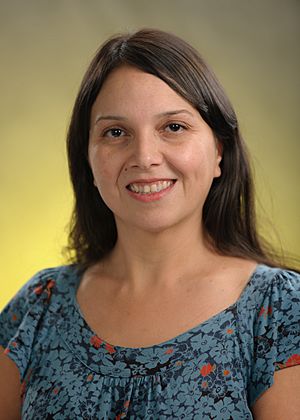Elisa Quintana facts for kids
Quick facts for kids
Elisa Victoria Quintana
|
|
|---|---|

Quintana backed by an artist's impression of Kepler 186f
|
|
| Born | 1973 (age 51–52) |
| Alma mater | University of Michigan, Grossmont College, University of California at San Diego |
| Known for | Astronomy |
| Scientific career | |
| Fields | Astronomy |
| Institutions | Astrophysicist NASA Goddard Space Flight Center |
| Doctoral advisor | Fred Adams |
Elisa Victoria Quintana is an American scientist. She works at NASA Goddard Space Flight Center. Her job is to study astronomy and planetary science. She looks for exoplanets, which are planets outside our solar system. She also studies how these planets are made.
Dr. Quintana is famous for finding Kepler 186f. This was the first planet about the size of Earth. It was found in the "habitable zone" of another star. The habitable zone is where it's not too hot or too cold for liquid water. This means life might be possible there.
Contents
Elisa Quintana's Early Life and School
Elisa Quintana was born in Silver City, New Mexico. Her father, Leroy Quintana, is a poet. Her grandfather was a miner. He was in a movie called Salt of the Earth.
When she was nine, her family moved to San Diego. She went to Grossmont College. Then she went to the University of California at San Diego. There, she earned a degree in Physics. While in college, she worked on a program called EarthKAM. She worked with Sally Ride, the first American woman astronaut.
Dr. Quintana earned two master's degrees. One was in Aerospace Science. The other was in Physics. Both were from the University of Michigan. She also got her PhD in Physics from the same university in 2004. Her PhD research was about how planets form around two stars. She was one of the first to study if planets could form in the Alpha Centauri star system.
Her Career in Science
From 2006 to 2017, Dr. Quintana worked on the Kepler Mission team. This was at NASA Ames Research Center. She helped create computer programs for the Kepler telescope. For this work, she won the NASA Software of the Year award in 2010.
She helped discover many important exoplanets:
- Kepler-10b: The first rocky exoplanet found.
- Kepler-22b: The first exoplanet found orbiting in a star's habitable zone.
- Kepler-20e: The first exoplanet found that was about the size of Earth.
In 2014, Dr. Quintana led the team that found Kepler-186f. This planet is Earth-sized and orbits a red dwarf star. It is also in the habitable zone. This discovery was published in the famous journal Science.
Dr. Quintana also studies how often "giant impacts" happen on exoplanets. She compares this to how often they happened on Earth. In 2017, she moved to the Goddard Space Flight Center in Maryland. There, she helps with two big projects:
Dr. Quintana is one of the few female Hispanic scientists in astronomy.
Awards and Special Recognitions
Elisa Quintana has received several awards for her important work:
- 2014: Lupe Ontiveros Dream Award
- 2015: Scientist of the Year award from Great Minds in STEM. This was for her discovery of Kepler-186f.
- 2019: Goddard Space Flight Center Honors Award for Leadership.
- 2020: Honor Award - Equal Employment Opportunity Medal.
See also
 In Spanish: Elisa Quintana para niños
In Spanish: Elisa Quintana para niños

